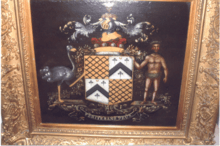Baron Willoughby of Parham

Baron Willoughby of Parham was a title in the Peerage of England with two creations. The first creation was for Sir William Willoughby who was raised to the peerage under letters patent in 1547, with the remainder to his heirs male of body.[1] The second creation was by writ in 1679, without the restriction on inheritance by gender.[2][3] The creation of the barony gave right to an hereditary peerage and seat in the House of Lords, the upper house of Parliament.
The barony was created on 20 February 1547 for Sir William Willoughby, a descendant of William Willoughby, 5th Baron Willoughby de Eresby living 1370 to 1409.[4] His son Charles Willoughby, 2nd Baron Willoughby of Parham had married Lady Margaret Clinton and through her all descendants thereafter can trace their ancestry to Edward I, King of England.[5]
The family of Willoughby, by a pedigree drawn up in the time of Elizabeth I, appears to be descended from Sir John De Willoughby, a Norman knight, who had the lordship of Willoughby, in Lincolnshire, by gift of the William the Conqueror between 1066 and 1087.[4]
The first creation of the Barony, 1547 is considered extinct as having no male heir on the death of the 17th Baron, George Willoughby, on 29 October 1779.[6] There may still exist a male heir.[7][8]
Parham, Suffolk

Theobald, son of Robert Lord Valoins, founder of Hickling Priory, in Norfolk, in 1185, endowed it with the churches of Parham and Hasketon. He was owner of the lordship of Parham, and a descendant of Peter de Valoins, a Baron, in the Conqueror's time. Cecily, the daughter of Robert de Valoins married Sir Robert de Ufford, Steward of the Household to King Edward II, and inherited this estate in right of such marriage. It continued in the house of Ufford until the decease of William d'Ufford, Earl of Suffolk when it descended to Cicely, his eldest sister, who married John, 3rd Lord Willoughby de Eresby. Robert their son, 4th Baron Willoughby de Eresby succeeded to this estate, as nephew and co-heir of the said William de Ufford, Earl of Suffolk. This Earl built Parham church, and bequeathed his body to be buried at Campsey Abbey, under the arch of St. Nicholas Chapel, behind the tomb of his father and mother.
Christopher, 10th Baron Willoughby de Eresby, married Margaret, daughter of Sir William Jenney, of Knottishall Knt, and gave the estate to his second son, Sir Christopher Willoughby who married Elizabeth, daughter of Sir George Talbois and it was their son William Willoughby who was created 1st Baron Willoughby of Parham and was Lieutenant of Calais. He married Elizabeth, daughter and co-heir of Sir Thomas Heneage. Their son was Charles, Lord Willoughby, who married Margaret, daughter of Edward Clinton, 1st Earl of Lincoln. Their male descendants continued to be titled Baron Willoughby of Parham until 1779.
Between 1680 and 1690, Parham Hall, formerly the property and residence of the Lords Willoughby of Parham, was purchased by the family of Corrance of Rendlesham.[9]
Barons Willoughby of Parham (1547)
- William Willoughby, 1st Baron Willoughby of Parham (c. 1515–1570)
- Charles Willoughby, 2nd Baron Willoughby of Parham (c. 1536/37–c. 1610/12)
- William Willoughby, 3rd Baron Willoughby of Parham (1584–1617)
- Henry Willoughby, 4th Baron Willoughby of Parham (c. 1612–1617)
- Francis Willoughby, 5th Baron Willoughby of Parham (1614–1666)
- William Willoughby, 6th Baron Willoughby of Parham (c. 1616–1673)
- George Willoughby, 7th Baron Willoughby of Parham (1638–1674)
- John Willoughby, 8th Baron Willoughby of Parham (1669–1678)
- John Willoughby, 9th Baron Willoughby of Parham (1643–1678)
- Charles Willoughby, 10th Baron Willoughby of Parham (1650–1679)
Barons Willoughby of Parham (1679)
- Thomas Willoughby, 11th Baron Willoughby of Parham (c. 1602–1691)
- Hugh Willoughby, 12th Baron Willoughby of Parham (1637–1712)
- Edward Willoughby, 13th Baron Willoughby of Parham (1676–1713)
- Charles Willoughby, 14th Baron Willoughby of Parham (1681–1715)
- Hugh Willoughby, 15th Baron Willoughby of Parham (c. 1713–1765)
Barons Willoughby of Parham (1547; Reverted)
- Henry Willoughby, 16th Baron Willoughby of Parham (1696–1775)
- George Willoughby, 17th Baron Willoughby of Parham (c. 1748/49–1779)
Family tree
This family tree includes only Barons Willoughby of Parham and their descendants who are relevant to the succession.[1]
| William Willoughby, 1st Baron (c. 1515–1570) | |||||||||||||||||||||||||||||||||||||||||||||||
| Charles Willoughby, 2nd Baron (c. 1536/37–c. 1610/12) | |||||||||||||||||||||||||||||||||||||||||||||||
| William Willoughby (died 1601) | Sir Ambrose Willoughby (died 1608) | Sir Thomas Willoughby | |||||||||||||||||||||||||||||||||||||||||||||
| William Willoughby, 3rd Baron (1584–1617) | Edward Willoughby (died 1650) | Thomas Willoughby, 11th Baron (c.1602–1691) | |||||||||||||||||||||||||||||||||||||||||||||
| Henry Willoughby, 4th Baron (c. 1612–1617) | Francis Willoughby, 5th Baron (1614–1666) | William Willoughby, 6th Baron (c.1616–1673) | Henry Willoughby (1626–1685) | Hugh Willoughby, 12th Baron (1637–1712) | Francis Willoughby | ||||||||||||||||||||||||||||||||||||||||||
| George Willoughby, 7th Baron (1638–1674) | John Willoughby, 9th Baron (1643–1678) | Charles Willoughby, 10th Baron (1650–1679) | Henry Willoughby (1665–1722) | Edward Willoughby, 13th Baron (1676–1713) | Charles Willoughby, 14th Baron (1681–1715) | ||||||||||||||||||||||||||||||||||||||||||
| John Willoughby, 8th Baron (1669–1678) | Henry Willoughby, 16th Baron (1696–1775) | Fortune Willoughby (died 1750) | Hugh Willoughby, 15th Baron (c.1713–1765) | ||||||||||||||||||||||||||||||||||||||||||||
| George Willoughby, 17th Baron (c.1748/49–1779) | |||||||||||||||||||||||||||||||||||||||||||||||
Notes
- 1 2 Burke 1831, pp. 575–578.
- ↑ Cruise on dignities, pg 202
- ↑ Hampson 1893, pp. 70–71.
- 1 2 Shaw 1940, p. 275.
- ↑ Shaw 1940, p. 281.
- ↑ Brydges 1805, pp. 189–190.
- ↑ Waters 1876, p. 69.
- ↑ Shaw 1940, p. 280.
- ↑ Page 1844, pp. 187–190.
Bibliography
- Brydges, Samuel Egerton (1805). Censura Literaria, Titles, Abtracts and Opinions of Old English Books. Volume 1. London: T. Bentley.
- Burke, John (1831). A Genealogical and Heraldic Dictionary of the Peerages of England, Ireland, and Scotland, Extinct, Dormant, and in Abeyance. London: Henry Colburn and Richard Bentley.
- Hampson, Thomas (1893). History of Rivington. Wigan: "Observer" Office.
- Shaw, Ronald Cunliffe (1940). The Records of a Lancashire Family from the XIIth to the XXth Century [On the Shaw family. With plates and genealogical tables.] Preston: Guardian Press. ASIN B0017XWD3Q.
- Smith, M.D. (1989). Rivington, Lancashire. Chorley: Nelson Brothers Printers Limited. ISBN 0-9508772-8-X.
- Page, Augustine (1844). A Supplement to the Suffolk Traveller; or Topographical and Genealogical collections, concerning that county. Ipswich: Joshua Page.
- Waters, Henry Fritz-Gilbert (1876). The New England Historical and Genealogical Register. Volume XXX. Boston: New England Historic Genealogical Society.